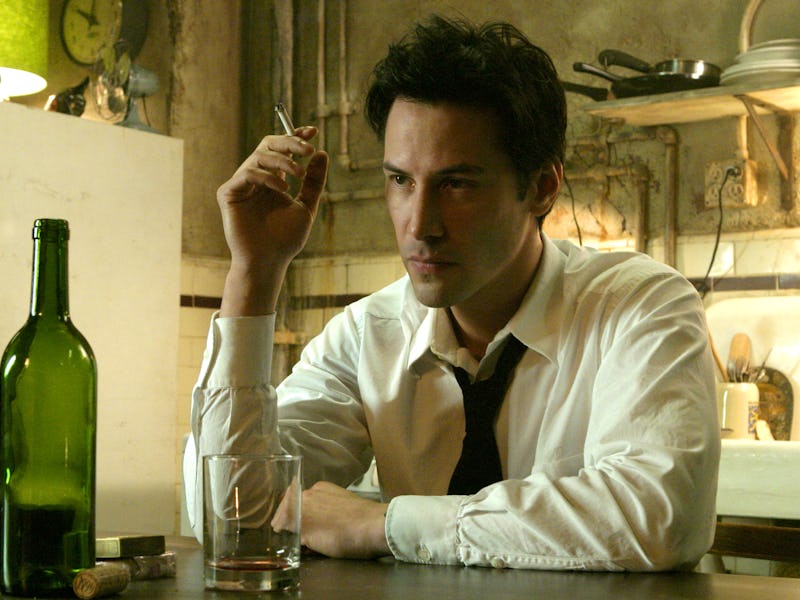Constantine is a Terrible Hellblazer Adaptation — But It Has Undeniable Style
Why be accurate when you can look cool as hell?

All too often, bad comic book adaptations suffer from depressingly similar problems. Surrounded by an unmistakable aura of studio executive interference, they reshape distinctive source material into commercially palatable dreck. They fail to understand the appeal of their own protagonists, and insert action scenes where they don’t belong. On paper, Constantine hits every one of these marks, swapping the Hellblazer comics’ edgy personality and political underpinnings for a more generic brand of urban fantasy. And that’s before we get into the issues caused by transposing occult detective John Constantine from England to L.A.
Yet thanks to its star power (Keanu Reeves! Rachel Weisz! Tilda Swinton!) and visual flare, Constantine has stood the test of time. It created its own appeal, separate from the comics. So much so that 20 years later, the arrival of a new 4K release feels welcome, inviting us to revisit a flawed but eminently rewatchable moment in Warner Bros.’s sprawling DC multiverse.
Launched by DC Comics in 1988, Hellblazer combined noir influences with a grimy punk rock sensibility, rooted in Thatcher-era Britain. It introduced John Constantine as a cynical, manipulative anti-hero who was just as likely to trick his way out of trouble than employ any magical techniques. Repeatedly undercutting any hints of conventional heroism, his exploits were littered with self-sabotage and messy relationships.
Constantine’s moral ambiguity made him an ideal fit for DC’s adult-rated Vertigo imprint, while his background as a working-class Englishman put a unique spin on the comics’ fantasy/horror worldbuilding. A lot of his early storylines involved direct commentary on British class system; a defining trait that evidently wasn’t prioritized when Warner Bros. launched a big-budget adaptation. Needless to say, this film also sidestepped his bisexuality.
Directed by Francis Lawrence (who went on to helm most of the Hunger Games movies), Constantine reimagines its title character as an ill-tempered American exorcist, slotting him into a Hollywood-friendly quest narrative involving a lost Biblical artifact, a troubled LAPD detective (Rachel Weisz), and an apocalyptic conflict between Heaven and Hell. There’s even a cringeworthy sidekick role for Shia LaBeouf as Constantine’s driver Chas; another reimagined character from the comics.
The monochromatic suit may not have been accurate to John Constantine’s signature beige coat, but it’s a uniform that’s served Keanu Reeves well.
Undeniably derivative, Constantine’s influences lean more toward Buffy and Angel than Hellblazer, and its opening sequence is a direct homage to The Exorcist. The main trait Keanu Reeves’ Constantine shares with his comicbook counterpart is his chain-smoking — a detail that’s foregrounded in his first appearance onscreen.
Shot from below, Constantine's hand drops a cigarette butt out of a taxicab window. Seconds later he’s lighting his next smoke on the way into an exorcism, wearing a plain black suit with the tie pulled loose around his neck. This costuming choice establishes what to expect from here on out, both good and bad. While it’s an explicit departure from John Constantine’s signature beige trenchcoat, this makeover also taps into Keanu Reeves’ effortless sense of cool, putting him in a monochrome wardrobe that served him well in other roles, from The Matrix to John Wick. The message is clear. This isn’t a John Constantine movie, it’s a Keanu Reeves movie.
Keanu probably couldn’t play a snarky Liverpudlian con artist, but he can carry off what Constantine ultimately delivers: A supernatural neo-noir drama with plenty of style, released at a time when silly studio blockbusters had a lot more aesthetic personality. Unsurprisingly, its CGI sequences don’t hold up, but if anything, that highlights how good everything else looks compared to the average comic book movie today. Traveling between demonic nightclubs, eerie hospitals, and cluttered apartments, Constantine is full of evocative, textured scenery, creating an atmospheric backdrop for larger-than-life characters like Tilda Swinton’s archangel Gabriel — possibly the film’s greatest highlight.
Tilda Swinton’s androgynous angel Gabriel was a highlight.
Arriving shortly before her role as the White Witch in the Narnia franchise, this was Swinton's first foray into blockbuster cinema. As the androgynous and snappily-dressed Gabriel, she elevates every scene; an ethereal yet implacable presence who mercilessly assures Constantine that he’s destined for hell. It’s one of those showstopper roles where you can’t imagine anyone else doing a better job, making it very obvious why Tilda Swinton is so often cast as a supernatural entity.
Piggybacking off Keanu’s post-Matrix fame, Constantine belongs to an early-2000s trend for urban fantasy horror, populated by badass protagonists battling the forces of darkness while wearing implausibly cool outfits. Blade kicked things off in 1998, followed by Hellboy, Underworld and a lineage of Matrix-adjacent sci-fi releases like Aeon Flux and Equilibrium, trailing off with late-2000s flops like Legion (which, like Constantine, involves angels and a Christian apocalypse). This subgenre faded after the superhero boom took hold, which likely plays into Constantine’s growing nostalgia value. Two decades on from its original spate of middling reviews, there’s enough demand that a sequel is now in the works.
Constantine may be a terrible Hellblazer adaptation but it is, I’d argue, a pretty good movie in its own right, with qualities that outshine a lot of recent DC/Marvel spinoffs. The underlying message here? If you’re going to make an ill-conceived adaptation based on a visual medium, you’d better make sure it looks good.